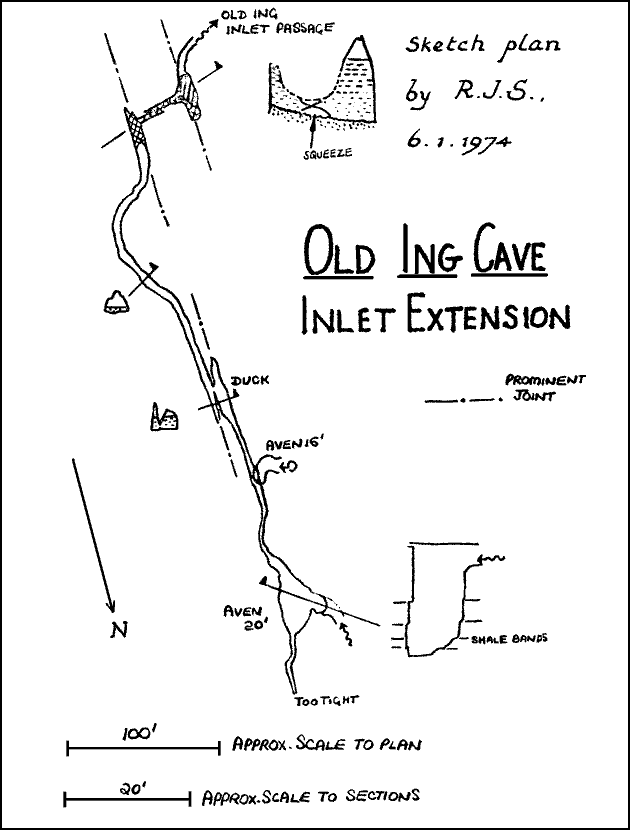
[Editor's note: the Report of Richard Durham's dive is included here as it leads on to the reports of Rob Shackleton's dives.]
While on a trip to have a look at the main sump, he also investigated a small inlet sump, which had not previously been dived. The inlet is marked in the top right hand corner of Jim Penny's map, CDG NL No. 26, January 1973, p.12. He thinks the water may come from Rough Mire Sink.
The sump, which was at right angles to the passage was entered and was found to be about 10 ft. deep. The passage was an uncomfortable size for about the first 10 ft. after which an archway was noticed in the left hand wall. This led to a parallel rift which gradually increased in size. The roof rose gradually and the surface was eventually reached in a deep, low air-space canal, after a total dive of 30 to 40 ft. The canal continued witb the roof still rising but owing to light difficulties, further exploration was impossible. The line was tied off on to two thin stals, being the only things available, and the diver then returned to base.
The dive was carried out in low water conditions and good visibility. Due to the shape of the roof the dive could be appreciably longer in higher water conditions.
Richard Durham
On arriving at the sump and staring disbelievingly at the vast quantities of water emerging, we decided that to try surveying under the conditions would be futile, nevertheless we dived through with the intention of attempting to climb the aven at the end. The sump, whilst only 30 ft. long, is quite awkward and should not be free dived. A vertical dive of some 10 ft. leads to a small portcullis window (which is quite exotic on the return journey) which leads into a roomy rift beyond. The sump continues for 20 ft. becoming more shallow and emerges in a roomy passage with a convenient little ledge for storing one's kit. The extension is very similar in character to the inlet at the other side of the sump excepting the fact that the walls and floor are more muddy. The passage is canal type and leads via several sections of hands and knees crawling interspersed with wading, to a deeper section and duck leading into a parallel joint. From here on the passage is hands and knees work passing beneath a dry aven and ending at an impressive chamber with a 20 ft. waterfall. The passage at the top appears to be 3 to 4 ft. high but there was too much water coming down to attempt to climb up. The climb should be O.K. in drier weather. The dry aven was climbed and leads to an impenetrable bedding plane at the top. (Sketch plan opposite p 16)
The purpose of this dive was to find the way on in the pool below the recent extension and to see if it would be feasible to connect with Dismal Hill Cave or Red Moss Pot. The visibility was very bad due to high water and our thrashing about in the inlet on the dive mentioned above. After spending about fifteen minutes getting absolutely nowhere in the 'pea soup' conditions it became obvious that the dive was a waste of time.
R.J.Shackleton

Aim: To search the left hand wall of the final canal with a view to locating a "window" short cut into the Red Moss Water. Such a short cut could shorten the connection by as much as 150 ft.
A thorough search was made in excellent visibility and the walls of the canal were found to be solid. The way to Red Moss must be large submerged passage described in NL 33:11, and not via the first Old Ing Sump as suggested by the report and sketch plan in NL 26:12. This would explain J.Parker's unsuccessful dive of 400 ft. from Red Moss (NL 35:20). I would expect the connection sump to be in excess of 500 ft. long.
R.J.S.